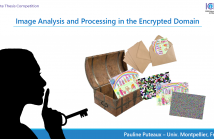
- Read more about One-class Learning Towards Synthetic Voice Spoofing Detection (Poster)
- Log in to post comments
Human voices can be used to authenticate the identity of the speaker, but the automatic speaker verification (ASV) systems are vulnerable to voice spoofing attacks, such as impersonation, replay, text-to-speech, and voice conversion. Recently, researchers developed anti-spoofing techniques to improve the reliability of ASV systems against spoofing attacks. However, most methods encounter difficulties in detecting unknown attacks in practical use, which often have different statistical distributions from known attacks.
- Categories:
 46 Views
46 Views
- Read more about On the Transferability of Adversarial Examples Against CNN-Based Image Forensics
- Log in to post comments
Recent studies have shown that Convolutional Neural Networks (CNN) are relatively easy to attack through the generation of so-called adversarial examples. Such vulnerability also affects CNN-based image forensic tools. Research in deep learning has shown that adversarial examples exhibit a certain degree of transferability, i.e., they maintain part of their effectiveness even against CNN models other than the one targeted by the attack. This is a very strong property undermining the usability of CNN’s in security-oriented applications.
- Categories:
 119 Views
119 Views
- Read more about Effectiveness of random deep feature selection for securing image manipulation detectors against adversarial examples
- Log in to post comments
We investigate if the random feature selection approach proposed in [1] to improve the robustness of forensic detectors to targeted attacks, can be extended to detectors based on deep learning features. In particular, we study the transferability of adversarial examples targeting an original CNN image manipulation detector to other detectors (a fully connected neural network and a linear SVM) that rely on a random subset of the features extracted from the flatten layer of the original network.
- Categories:
 71 Views
71 Views
- Read more about Effectiveness of Random Deep Feature Selection for securing image manipulation detectors against adversarial examples
- Log in to post comments
We investigate if the random feature selection approach proposed in [1] to improve the robustness of forensic detectors to targeted attacks, can be extended to detectors based on deep learning features. In particular, we study the transferability of adversarial examples targeting an original CNN image manipulation detector to other detectors (a fully connected neural network and a linear SVM) that rely on a random subset of the features extracted from the flatten layer of the original network.
- Categories:
 32 Views
32 Views
- Read more about AN IMAGE IDENTIFICATION SCHEME OF ENCRYPTED JPEG IMAGES FOR PRIVACY PRESERVING PHOTO SHARING SERVICES
- Log in to post comments
- Categories:
 33 Views
33 Views
In this research project, we are interested by finding solutions to the problem of image analysis and processing in the encrypted domain. For security reasons, more and more digital data are transferred or stored in the encrypted domain. However, during the transmission or the archiving of encrypted images, it is often necessary to analyze or process them, without knowing the original content or the secret key used during the encryption phase. We propose to work on this problem, by associating theoretical aspects with numerous applications.
- Categories:
 160 Views
160 Views
- Read more about Privacy Protection for Social Media based on a Hierarchical Secret Image Sharing Scheme
- Log in to post comments
Social network development raises many issues relating to privacy protection for images. In particular, multi-party privacy protection conflicts can take place when an image is published by only one of its owners. Indeed, privacy settings applied to this image are those of its owner and people on the image are not involved in the process. In this paper, we propose a new hierarchical secret image sharing scheme for social networks in order to answer this problem.
- Categories:
 15 Views
15 Views